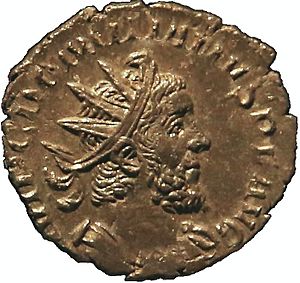Domitian II facts for kids
Quick facts for kids Domitian II |
|||||||||
|---|---|---|---|---|---|---|---|---|---|
| Usurper of the Gallic Empire | |||||||||

Coin portrait of Domitian II, inscribed:
imp·c·domitianus p·f· aug· |
|||||||||
| Reign | c. 271 | ||||||||
| Predecessor | Victorinus | ||||||||
| Successor | Tetricus I | ||||||||
| Died | c. 271 | ||||||||
|
|||||||||
Domitian II (also known as Domitianus) was a Roman soldier who lived around the year 271 AD. He was declared "emperor" by some people, likely in northern Gaul (which is modern-day France). He even made coins to show he was in charge.
However, Domitian II was not a widely accepted emperor. His rule probably lasted only a few weeks. He didn't get much support from the army or important leaders. Because of this, he is usually called a Roman usurper. A usurper is someone who tries to take power illegally. His attempt to become emperor happened during a difficult time for the Gallic Empire. This was a part of the Roman Empire that had broken away in the west.
Contents
Coins of Domitian II
The main proof that Domitian II existed comes from two special coins.
First Coin Discovery
One coin was found in 1900 in a hidden treasure in France. For a long time, people weren't sure if this coin was real or important. Some thought Domitian II might not have even existed.
Second Coin Discovery
Then, in 2003, another coin was found in England. This coin was stuck inside a pot with about 5,000 other coins from the same time. This proved that the coin was definitely real and from that period. The Ashmolean Museum bought this important coin in 2004.
Third Coin Discovery
In 2006, a third coin was found in Bulgaria by someone using a metal detector. This coin was different from the first two. The coins from France and England showed the goddess Concordia. This new coin from Bulgaria showed the goddess Laetitia. This unique coin is now kept at the Sofia National Museum of History.
What the Coins Look Like
The coins of Domitian II look like other coins made in the Gallic Empire. They are called "radiate" coins. This means they show Domitianus with a spiky crown, like the rays of the sun. This was a common way to show respect for the sun god, Sol Invictus. The pictures on the coins are not exact portraits. Instead, they are standard images, much like those on coins of other Gallic Emperors, like Victorinus and Tetricus I.
Coin Inscriptions
All the coins have the same words: IMP C DOMITIANUS P F AUG. This is a short way of saying Imperator Caesar Domitianus Pius Felix Augustus. It's interesting because it doesn't include Domitianus's full Roman name. Usually, Gallic Empire coins would have the full name to help with their messages.
On the back of the coins, there's a picture of the goddess Concordia. The words say CONCORDIA MILITVM. This was a message to say that the army was united behind Domitianus. This was also a common slogan used by the Gallic Emperors.
Where the Coins Were Made
The style of these coins suggests they were made by the mints (coin factories) of the Gallic Empire. These mints were likely in Trier (in modern-day Belgium) or Cologne (in modern-day Germany). This also tells us that the coins were made before 274 AD. That's when the Roman Emperor Aurelian took back control of the Gallic Empire.
Mentions in Old Writings
Domitian II is only mentioned in two old writings. Neither of these writings calls him an emperor.
Zosimus's Account
A historian named Zosimus, who lived in the 6th century, wrote about a Domitianus. He said this Domitianus was punished for a revolt during the time of Emperor Aurelian (270–275 AD). Zosimus didn't say exactly what Domitianus did wrong or who he was fighting against. Because Zosimus mentioned him during Aurelian's rule, some people think Domitianus was challenging Aurelian directly.
Historia Augusta's Account
Another old book, called the Historia Augusta, also mentions a Domitianus. This book says he was a general who helped stop a rebellion in 261 AD. It suggests that Domitianus was an important commander. However, this book does not say that this Domitianus was involved in any rebellions against Aurelian.
The Historia Augusta also claimed that Domitianus was related to an earlier emperor named Domitian. This might have been to make him seem more important or from a noble family.
See also
 In Spanish: Domiciano II para niños
In Spanish: Domiciano II para niños

